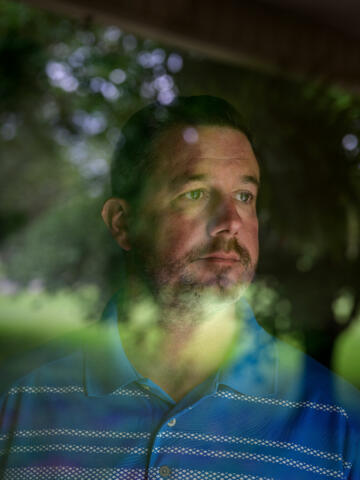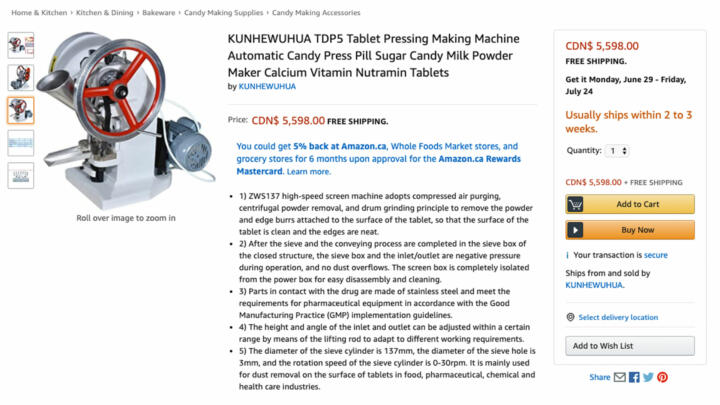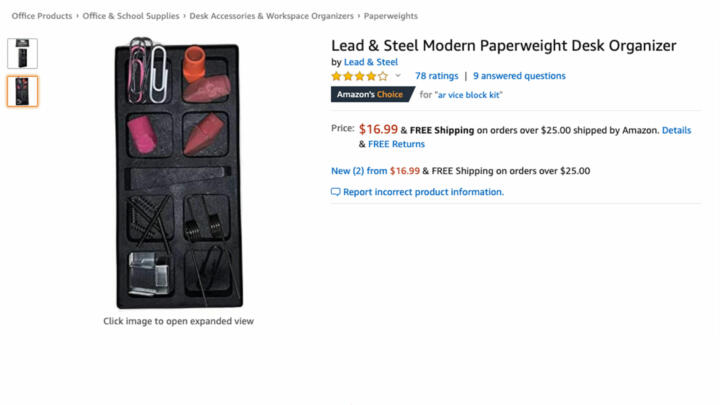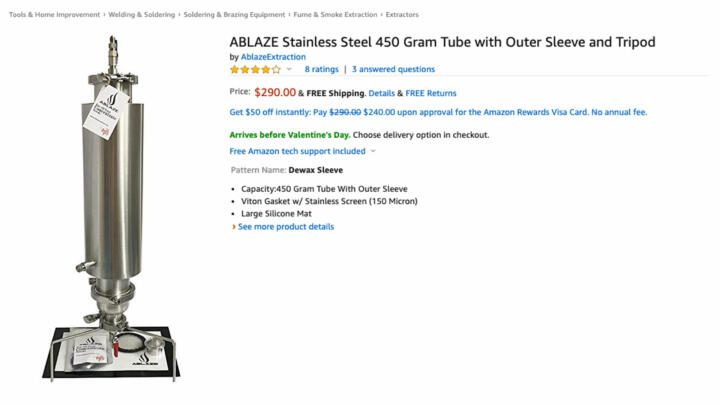Eric Falkowski said he made an easy living working a few hours a week making counterfeit prescription opioids before some two-dozen people overdosed and the authorities caught up with him.
He mixed fentanyl with active ingredients from Xanax and Tylenol and pressed the compound into pills that looked like Percocet, he said, down to the exact color and markings.
Where did he get the equipment? According to federal court records and Falkowski himself: Amazon.com.
“I purchased two pill presses on there. I also purchased the pill press dies, which are the molds to shape the pills and imprint them with whatever number they need be,” Falkowski said in a phone interview from prison, where he is serving a 22-year sentence for crimes connected to his counterfeit drug business.
“You search under the code on the pill … and it’ll just come up,” he added. “It really wasn’t that complex.”
Two people died after taking Falkowski’s pills, and another woman was found dead from an overdose on the property where he kept his makeshift lab, according to officials, law enforcement documents, and autopsy reports. More than 20 others were sickened by the pills but survived.
“Someone could wipe out a whole town” with these “poisonous pills,” said Derrick Helton, a former sheriff’s deputy for Rutherford County, Tenn., where the mass overdose took place. One of the fatalities was his sister Tiffanie Scott, a 33-year-old mother of a young daughter.
Amazon bans pill presses used to make prescription drugs. They’re included among 38 pages of third-party seller rules and prohibitions for its U.S. marketplace.
Yet an investigation by The Markup found that Amazon fails to properly enforce that list, allowing third-party sellers to put up and sell banned items.
Alongside its third-party marketplace, Amazon sells products to consumers directly, and The Markup found it was also selling banned items itself, revealing cracks in the largely automated purchasing system that feeds its massive product catalog.
We found nearly 100 listings for products that the company bans under its categories of drugs, theft, spying, weapons and other dangerous items, a virtual back alley where mostly third-party sellers peddle prohibited goods, some of which are used for illicit and potentially criminal activities.
Amazon's Choice?
The Markup filled a shopping cart with a bounty of banned items: marijuana bongs, “dab kits” used to inhale cannabis concentrates, “crackers” that can be used to get high on nitrous oxide, and compounds that reviews showed were used as injectable drugs.
We found two pill presses and a die used to shape tablets into a Transformers logo, which is among the characters that have been found imprinted on club drugs such as ecstasy. We found listings for prohibited tools for picking locks and jimmying open car doors. And we found AR-15 gun parts and accessories that Amazon specifically bans.
Almost three dozen listings for banned items were sold by third parties but available to ship from Amazon’s own warehouses. At least four were listed as “Amazon’s Choice.”
The phrase “ships from and sold by Amazon.com” appeared beneath the buy button of five of the banned items we found, which two former employees confirmed means those products are, in fact, sold by Amazon. In addition, one of the sellers we were able to reach also confirmed it sold the items to Amazon.
Many of the items we found had been up for sale for months, some with positive reviews showing they had been sold, including some of the items sold directly by Amazon.

Show Your WorkBanned Bounty
How We Investigated Banned Items on Amazon.com
It wasn’t that hard; Amazon’s own search and recommendation tools led the way
And Amazon led us right to the prohibited listings. When we typed “bong” into the website’s search bar, autocomplete suggestions included “bongs for smoking weed.” When we typed “pill press,” autocomplete suggested “pill press for making pills xanax.”
In a written statement to The Markup, Amazon spokesperson Patrick Graham said the company has “proactive measures in place to prevent suspicious or prohibited products from being listed,” and that the company stopped more than six billion “suspected bad listings” from posting last year, repeating the company’s remarks to Congress earlier this year.
“If products that are against our policies are found on our site, we immediately remove the listing, take action on the bad actor, and further improve our systems,” he said.
Graham did not respond directly to many of our specific questions, including how many of the banned items that The Markup found had been sold, why the company had not noticed some of them for months, why some were listed as Amazon’s Choice, and why many were stored in Amazon’s warehouses for shipment.
He did not respond at all to questions about why Amazon itself had offered banned items for sale.
Most of the banned listings we reported to Amazon have been removed, although at least three have popped back up.
The company removed the six specific terms that we mentioned from autocomplete, according to Graham, who said that feature is informed by “similar searches by other customers.” He wouldn’t say whether the company also removed all other banned items from autocomplete.
Graham also declined to explain why the company chose to allow 13 listings for banned items that we reported to the company to remain for sale. These products were specifically named as banned in Amazon’s rules, met the U.S. Department of Justice’s definition of drug paraphernalia, or were confirmed by two weapons experts to be a gun part or tool. Two of them were items that Amazon sells itself.
In addition to the nearly 100 listings for banned items we found for sale in the U.S. marketplace, we found several pill presses for sale on Amazon’s Canadian marketplace that were available for shipment to the United States. Amazon took them down after we reported them to the company, including a $4,100 TDP 5 Desktop Tablet Press, one of the models Falkowski used.
"Almost dead"
Michael “Shane” Shipley, 39, a native of Rutherford County, Tenn., was one of the people who died after taking Falkowski’s fake pills. He’d worked his entire adult life operating machinery at a local factory.
“I couldn’t even tell you what my dad’s death has done to my family,” his daughter Brittany Conway said in an interview.
Within a day of her father’s death, Conway said, she woke up in a hospital bed herself. She didn’t realize her father had slipped the counterfeit pills into his prescription bottle of Percocet at home and, distraught with grief, she had taken what she thought was a safe medication to help her relax.
“I went from up, talking—to almost dead,” Conway said.
Graham said Amazon’s policies allowed pill press sales when Falkowski was making counterfeit drugs in 2016. He declined comment on the overdoses and said, speaking in general, that the company is not responsible for harm from third-party product sales.
“We are not liable for those products because we do not make, distribute, or sell those products,” he said. He said that also applies to third-party products that are fulfilled by Amazon, which charges sellers to store and ship their items.
The company has successfully shielded itself from legal liability for harm caused by third-party products sold on its website by invoking Section 230 of the federal Communications Decency Act, which states websites are not responsible for third-party content that appears on their sites.
Last year, one federal appeals court ruled that Amazon may shoulder liability for a customer’s injuries from a defective product sold on its site, in part because the company “enables third-party vendors to conceal themselves from the customer, leaving customers injured by defective products with no direct recourse to the third-party vendor.”
Third-party sellers now make up 58% of all Amazon's sales
Percentage of Amazon's sales made by third-party sellers
0
20
40
60
80
100
2000
2003
2006
2009
2012
2015
2018

Three million third parties from across the globe are now selling on Amazon’s platforms, according to e-commerce intelligence firm Marketplace Pulse. And third-party sellers have fueled the company’s explosive growth for years, according to a 2019 report to shareholders. Last year, Amazon third-party sales reportedly topped $200 billion—a sum that rivals the annual GDP of New Zealand.
Will It "Kill Someone?"
Multiple current and former employees, most of whom asked not to be named for fear of retaliation, said the company struggles to oversee that army of independent sellers.
“Because sellers have the ability to upload items themselves to the website, it makes it very difficult to police all of that without hindering the ability to do business,” said a former member of the product safety team who left the company in 2018. “Amazon knows there’s tons and tons and tons of stuff that shouldn’t be on the website.
“We basically would categorize risks based on their severity,” the former employee added. “Will this product injure or kill someone? Is it high legal risk?”
An Amazon executive acknowledged in the statement to Congress earlier this year that “bad listings” get through but said the company is working to shore up the slippage of “counterfeits, unsafe products, and other types of abuse” by requiring sellers of certain items to be preapproved, partnering with brands to pull counterfeits, and enhancing “proactive” tools to spot problems.
Yet Amazon’s sellers’ tools sometimes help, rather than hinder, the listing of banned items, The Markup found.
When we opened a new seller account and started listing a bong for sale, Amazon suggested we list it as a vase in home decor. We never posted it.
Last month, we successfully listed two banned items for sale: an AR-15 10-round magazine and an AR-15 armorer’s wrench. We removed them within minutes of confirming they had posted. We were able to evade detection by Amazon’s automated filters by purchasing a universal product code for the magazine and by both avoiding specific keywords and miscategorizing the items.
The listings went up even though we had no seller history and had already twice been prohibited from listing the same items using more precise descriptions.
Graham declined to comment on why we were able to post these items but said Amazon’s sellers’ tools “suggest listing categories to help sellers easily categorize their products, but sellers are responsible for choosing the correct category, as they know their products best.” He also declined to comment on why the tools suggested an incorrect product category for listing bongs.
Other media have exposed Amazon’s lax product controls, including three reports just last year: a CNN investigation that documented dangerous child car seats, a CNBC report that revealed Amazon was shipping expired food and baby formula, and a Wall Street Journal investigation that found thousands of unsafe, banned, and deceptively labeled products on the site.
Graham said Amazon investigated these “with urgency” and sought to improve systems when needed but gave no specifics.
It may be more profitable to have the ‘wild, wild west’ of sales, but it’s also much more dangerous for consumers.
Lori Wallach, a director at Public Citizen
Consumer advocates say the company isn’t doing enough to protect the public, and regulators need to step in.
“It’s clear there’s not a major prioritization or investment in resources in policing the terms of service or ensuring that prohibited products are not sold,” said Lori Wallach, a director at the nonprofit organization Public Citizen. “It may be more profitable to have the ‘wild, wild west’ of sales, but it’s also much more dangerous for consumers.”
“We categorically disagree with this claim,” Graham replied.
Automating Enforcement
When Rachel Johnson Greer joined Amazon in 2010 as a product safety program manager, she said she found many problematic products for sale, from unapproved treatments of erectile dysfunction to illegal police radar jammers.
“They were up for sale and selling happily away on Amazon,” Greer said.
She said some troubling products were sold directly by Amazon itself, which she and others said relies on a mostly automated purchasing process.
“Ships and sold by Amazon is Amazon. This is how it all started,” said Greer, who worked for the company until 2017. “They built algorithms to figure out which books they needed to buy and then how much.”
It was Greer’s job to put an end to sketchy sales, she said. Her team wrote programs to flag undesirable products and amassed a universe of terms to feed an automated policing system. She said the tool eventually could scan billions of line items in the catalog in about five minutes.
But it proved flawed, she said. The system by its nature was confined to known threats—things it had seen before. Greer said new problems emerged all the time and slipped right through initial safeguards, only to be flagged by customers after something went wrong.
“The biggest problem with Amazon’s system to begin with is that nearly everything is reactive,” she said. “The reality is when you have a system that relies on finding defects per million, that means that there will always be defects.”
She said some third-party sellers devised “clever, tricky ways to list products. And these rules couldn’t catch it because they hadn’t been written by a human who was thinking in clever, tricky ways.”
No matter how much we remove, there’s always more.
Anonymous employee on the restricted products team
One current employee of the restricted products team wearily put it like this: “No matter how much we remove, there’s always more.”
Graham did not directly respond to these descriptions of the company’s difficulties in keeping restricted items off the site. Instead, he said more generally that Amazon strives “to make sure that all products in our store are safe” and “we continuously monitor the products sold in our stores.”
Yet we found an unproven treatment to fight cancer with electromagnetic frequencies that is banned by Amazon’s policies—a rife machine—had been on the site for five years. The listing was removed after we contacted Amazon.
While most of the specific banned listings we brought to Amazon’s attention were removed, similar items that we did not report to the company remained live, including some listings by the same third-party sellers.
Many of the sellers of the banned items that we found continued to sell banned products, including Lead and Steel, which sold gun accessories, and another company, which sold a compound that reviewers said they used as injectable drugs. When we asked Amazon about this in follow-up questions, those storefronts disappeared from Amazon.com.
Graham denied that injectable drugs were sold on its platform, saying they were not sold for that purpose but rather marketed for “research” in the listing. Of the two compounds we found, the World Anti-Doping Agency designates one, TB-500, as a “prohibited substance,” and the U.S. Anti-Doping Agency warned athletes about the risks of the second one, BPC-157, as not approved for human use. Customer reviews on the listing showed people were injecting the product.
Graham said the company removed the listings and would add them to its banned product list “out of an abundance of caution.” But as of publication, both compounds could be found for sale by other sellers on Amazon.com.
Amazon isn’t the only online retailer that has had to grapple with policing the unruly world of third-party e-commerce, where just about anybody can sell just about anything. Falkowski said he bought some of his drug-making supplies on another site.
Some marketplaces are known for thoroughly reviewing products before they go up.
Apple, which offers mobile apps from third-parties, checks the code before any app or update appears in the App Store, for instance. According to its site, Apple uses a combination of automated systems and hundreds of human experts speaking a total of 81 languages to review them before posting.
“We take responsibility for ensuring that apps are held to a high standard for privacy, security, and content,” Apple’s website states, “because nothing is more important than maintaining the trust of our users.”
Amazon’s users appear to know exactly what they’re buying, even when banned products are lightly disguised.
Lead and Steel listed a gunsmithing tool for an AR-15 as a “paperweight desk organizer,” posting a photo of the vise block holding paper clips and erasers.
Customers joined in on the ruse in reviews. “Helps when you need to do a hands free clean up of your desktop,” wrote one. “Locks items solidly into place, will Load plenty of paper clips or tacks.”
Another customer retorted, “Sorry. I’m not playing along. I can buy AR-15 parts all day on Amazon.”
To go along with the vise block, Amazon’s “frequently bought together” tool suggested other gunsmithing tools, showing at least one of Amazon’s automated systems received signals that it was not an office product.
Graham, the Amazon spokesperson, declined to explain why the items were still for sale, even though the “frequently bought together” tool seemed to recognize they were related to firearms.
Lead and Steel, which declined to be interviewed for this story, had sold at least four dozen vise blocks from that posting since it went up in December, according to reviews, until we reported it to Amazon, which pulled the listing.
On the Hunt for Honey Oil Equipment
Vic Massenkoff, a retired fire investigator from Contra Costa County, Calif. said he tried years ago to get Amazon to take down dangerous equipment—but said he was frustrated by what he sees as the company’s inaction.
He said he’d seen too many fires caused by the process of extracting highly potent hash oil, or “honey oil,” from marijuana using butane and in 2013 decided to investigate where the equipment could be found for sale. He said he found it on Amazon.com.
“There it was lined up, everything from the extraction tubes, to the grams digital scales, to the silicone pads, the silicone containers, to the digital thermometers,” Massenkoff said. “Everything you would need to set up shop.”
When he clicked on a listing for the glass tubes, Amazon’s recommendation engine suggested he buy the other items needed to make and use hash oil. He kept screenshots of the suggestions.
“There is no safe way to make butane honey oil,” he said in an interview.
He said he emailed Amazon from his work email to alert the company to the danger. He still remembers the reply: “Thanks for bringing this to our attention. We have assigned it to someone on our staff to research this.”
He said he got one other email from Amazon and then heard nothing.
Graham, the Amazon spokesperson, declined to say how the company handled Massenkoff’s complaint, for which he said The Markup had provided no “evidence.”
Amazon’s current rules ban the sale of equipment to make hash oil; we were able to find it on the site.









